When was your Selmer Paris Saxophone made?
If you are wanting to sell your Selmer saxophone, we are always buying vintage saxophones. Please email us at getasax@gmail.com
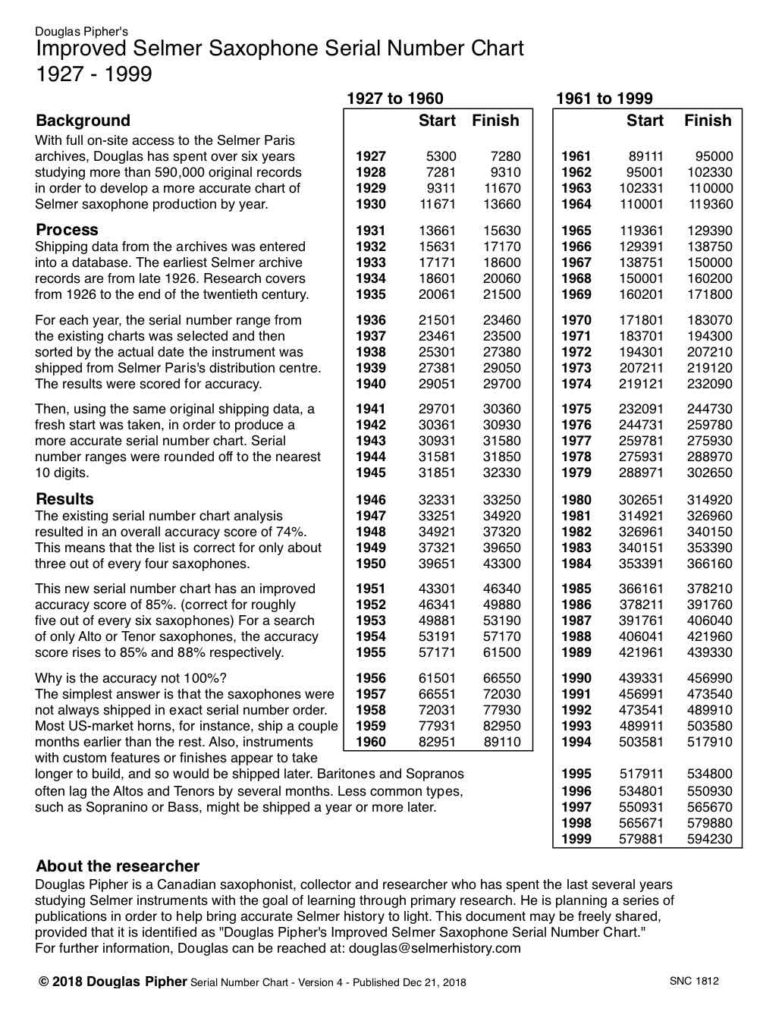
Selmer paris saxophone serial number chart
This is the most accurate Selmer Serial Number Chart on the internet!
Friend of GetASax.com Douglas Pipher has been given unprecedented access to the Selmer Paris archives, and after thousands of hours of research has compiled a brand new and more accurate Selmer Serial Number Chart for Selmer saxophones. With permission, we have printed the results of his research below.
And here’s a 2023 Update with a DETAILED Selmer saxophone serial number chart showing every significant change that takes place in Selmer design along with the serial number when it first appears. Amazing!
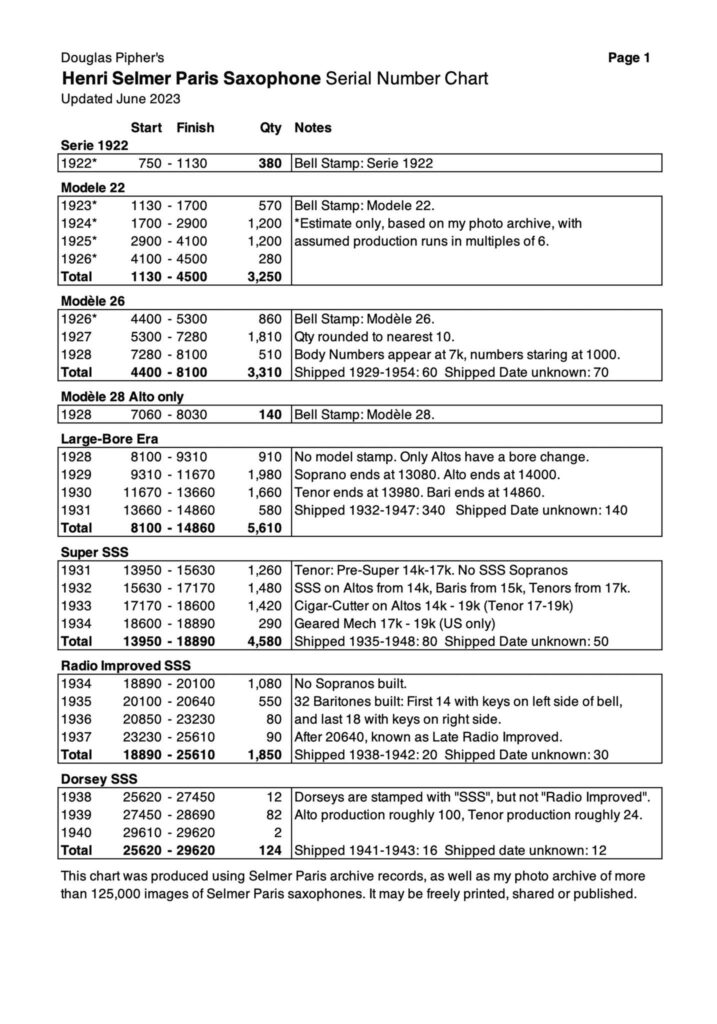
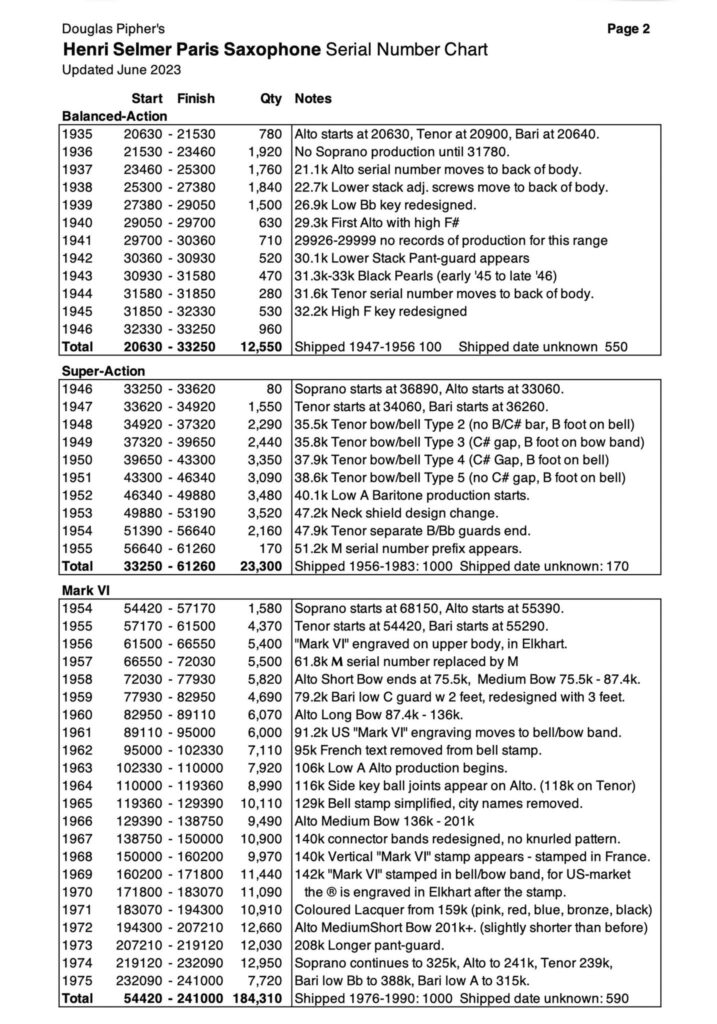
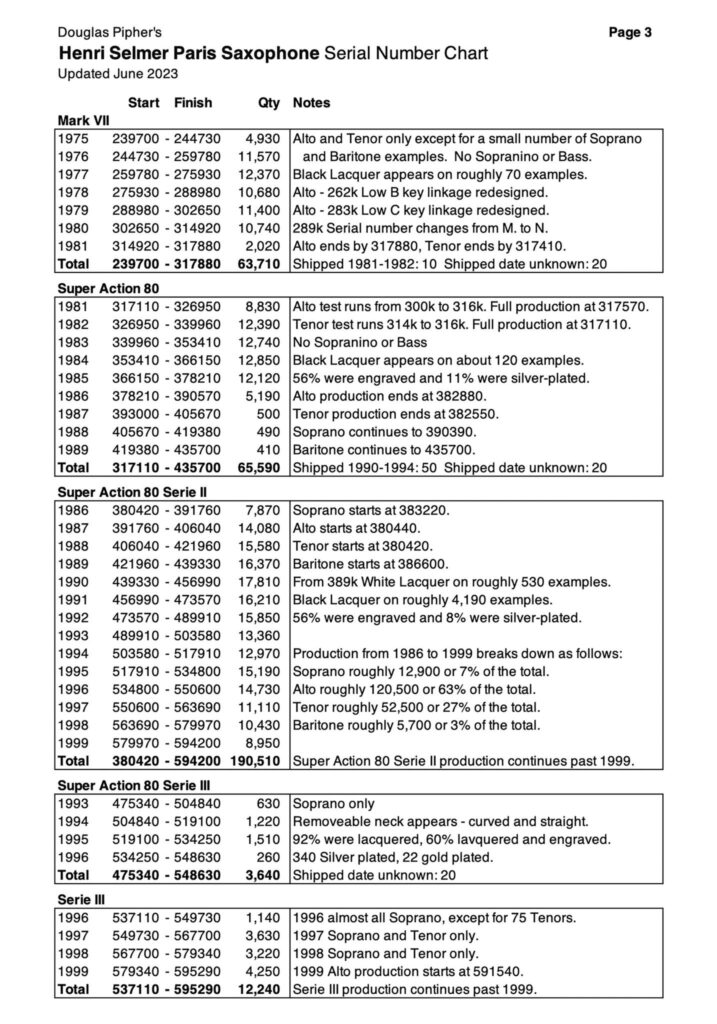
Selmer Serial Numbers – a Fresh Approach
Douglas Pipher, June 20, 2017
The existing Selmer Serial Number Chart has been available on the internet for years. Many saxophonists use it as the authority for determining when an instrument was made. But there are problems with the existing chart, such as the timing of the introduction of the different models. It seems unlikely that every new model was introduced exactly at the beginning of a new year. It also seems unlikely that each year’s production ended at a conveniently round number. Was the chart built from specific data or was it just someone’s estimate; a guess which eventually became assumed to be an absolute truth? With these questions in mind, the need for a fresh look became clear, to see if there was a way to measure the accuracy, or inaccuracy, of the existing chart. Douglas Pipher decided to take on the challenge.
Clearly the first step was to collect as much primary data as possible. It is well known that Selmer Paris possesses some archival records but they are not available to the public. With a background in statistical analysis and an established record in the study of Selmer history, Douglas was able to secure access to these archives. Once there, the daunting nature of the task became apparent. The archives are comprised of a series of very old and fragile notebooks, written by a variety of people, in a variety of handwriting styles. Some were neat and detailed and others were nearly illegible and of course, it is all written in French. But, the fact that all the data still existed was like finding a treasure.
The archive records contain four key elements:
– Instrument type (Alto, Tenor etc)
– Finish and custom features
– Shipping date
– Destination
In most cases, there was no mention of what model was being produced. The data started at serial #5000 and continued for over 75 years. Whether earlier notebooks were lost or were never kept is unfortunately unknown.
The first phase of the research was to study the records from the beginning up to the end of the Mark VI era. (1927 to 1975) After several trips to Paris and several thousand hours of research and study, the original shipping data was collected and organized. Finally, it was possible to do a detailed study of each year’s actual sales and compare them the to the information suggested in the existing serial number chart.
Let’s take a look at 1927, the earliest year for which full data was available.
The existing serial number chart showed a range from 5601 to 7850. By simple subtraction, 2249 saxophones were allegedly built in 1927. A search of the actual shipping dates for this serial number range revealed the following:
Only 1537 saxophones within this range were shipped in 1927. An additional 404 were shipped in 1928 and 27 more were shipped even later than that. Dividing the actual number (1537) by the alleged number (2249) revealed that the serial number range for 1927 was only 68% correct. Clearly, there was room for improvement.
This process was repeated for each year up to 1975. The average accuracy for the entire existing serial number chart was a disappointing 66%. That’s only two out of three! So about a third of the people using the list got the wrong year for their saxophone. It quickly became obvious that an improved chart was needed.
Fortunately, the primary shipping data could now be used to rebuild the serial number chart from scratch. Beginning with a list of all the actual 1927 sales, they were sorted by serial number. Next, they were grouped into serial number ranges of 100. (5000 – 5099, 5100 – 5199 etc) and the total number of 1927 sales within each group was calculated.
The chart at left shows that less than one quarter of the saxes in the 5000 to 5299 serial number range were sold in 1927. Most were sold in 1926. The range from 7300 to 7800 also showed less than half of the sales in 1927, with most of the remainder being sold in 1928. Between the 5300 and 7299 range, most of the saxes were sold in 1927. This range became the initial boundary for 1927 production. By taking a closer look, right down to individual instruments, the starting and ending points of the range were modified as needed. The most accurate serial number range for 1927 was finalized as 5300 – 7280. Repeating this process for each year up to 1975 resulted in the development of a chart with an average accuracy of 82%. For searches of Alto or Tenor only, the accuracy rose to 86%.
Why is the new chart not 100% accurate? A look at the 1927 chart to the left makes the answer quite clear. As mentioned above, the 1927 range was determined to be 5300 – 7280, so the 1928 serial number range logically started at 7281. But many saxophones from 7300 to 7800 were sold in 1927. The majority of the horns in this range which were sold in 1928, but clearly not all of them. There are many reasons for this. Different distributors had different specifications, which affected delivery times. The US-Market horns, for instance, were not normally engraved, padded or lacquered in France. This meant that US-Market horns shipped earlier than others.
The more unusual types of saxophones, such as the Sopranino or Bass, were often sold months or even years later than one might expect. Individual saxophones with custom finishes or features would naturally take longer to build, thus delaying their completion date. In building as complex an instrument as a saxophone, there are many reasons why and individual sax’s completion date could be delayed by days, weeks or months.
The improved serial number chart is by no means flawless. But it’s does allow for a far greater level of confidence for Selmer owners and enthusiasts. Douglas’ ongoing primary research continues to extend the scope of the improved chart, into the Mark VII range and beyond. Douglas Pipher is a Canadian saxophonist, collector and researcher who has spent the last several years studying Selmer instruments with the goal of improving our understanding of Selmer history through primary research. He can be reached at: douglas@selmerhistory.com

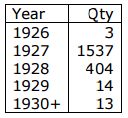

Tenor Radio Improved
19095
Call of 1934
Radio Improveds are some of my favorite vintage saxophones.
Hello, i had purchased a alto a radio improved, you said they are among your favorites, it needs a repad overhaul though it plays abit. What makes it one of your favorites? What are the good things? Ive not played a mk vi or bal action nor a SBA, and would like to compare, how would a RI model sound and play or be different or similar or the same? , etc., Thank you.
Quickest way would be to try to play some of the other models. RI’s are more spread, darker, and more wilder to play than BA and later Selmers. They have a warm, rich tone, and they vibrate well like Conn, feel wise. Later Selmers feature improved keywork and generally better tuning, but the tone is more focused, and gets brighter over time as a general rule.
Hello,
I was wondering if you have the same number chart but with the names of the models.
I have a Selmer Tenor #53943. Is it a SBA or is it a Mark 6
Thank You,
Reggie
You’re right, that would be useful. But it would actually also be a little tricky, for a number of reasons.
1. Selmer didn’t use model names early on, the way that we are used to thinking. There was no “official name” for the Selmer tenors around 15xxx serial, for example.
2. The keywork changes change at different times – the altos always change first, then tenors, and finally soprano, baritone and other voices (if ever)
3. So Selmer might be making a Mark VI alto at 53k, but a Super Action Baritone and tenor, and essentially a Modele 26 soprano!
4. Sometimes the first batch of horns with a given change could be followed by later horns that go back and have the older features.
I have a Selmer Paris tenor saxophone serial No 11705
Can you please clarify if this a cigar cutter or model 26 please?
This is probably a New Largebore tenor at that serial range. ‘Cigar Cutter’ usually means the certain octave mechanism that looks like one, and it is found almost exclusively on altos, though a few tenors in the 18k serial range got it.
I picked up Selmer Alto Sax (As-100) Made in the USA from my friend who purchased it a few years ago. I am guessing he bought it sometime around 2012 to 2013 (just a guess). I was looking to upgrade my YAZ model and he was moving. So he sold me his As-100 Serial #829121. He moved away and I can’t find him. Now I was online looking to see when this was made and what the Value maybe. I checked all the normal Cat# abd serial # web sites but I have had no luck. If anyone has any info or a possible web site that has this info. or maybe a updated phone number to call these guys. Thank would be great!! Please email it to me. Thanks a bunch!
Smitty
Fixradioshow@gmail.com
As far as age goes, the Selmer Paris saxophones have a different serial number chart than Selmer USA like you have. You can search eBay SOLD listings to get an idea of value on an AS-100 in similar shape to yours.
Hi
I have a silver plate selmer with two numbers. One on the bell (No 14234) and one on lower body (6424 C)
Which is the serial number and what is this horn please ?
Thanks for info and help
Regards
Ed
Hi Ed, Earlier Selmers had a body serial number that was used for keeping track of different body tubes, but that is not used to date the saxophones in the Selmer archives. So that’s what that number is on the lower body tube by the D tone hole.
I have a Selmer alto serial number 12269. What model is this most likely?
Probably that would be a New Largebore. Check out my other article breaking down Selmers by model. https://www.getasax.com/how-rare-is-your-selmer-saxophone/
I really would like to get that archive database if this is possible …
JAY I have a selmer alto sereal#163578 what is thi model most likely worth
I just picked up a Series III, serial number 645147. The previous owner says it was bought new in 2013/14, but what I found says 2003/04. Looed at the neck but could not find any numbers. Only on the bottom of bell. Is this standard?
Yes, the neck has no serial number on any Selmer saxophone except for the American-assembled ones from the late 30’s-early 60’s. The neck serial goes away around 134k serial or so. I’m not exactly sure what the last one is, but I have owned 132k’s with neck serial still there. So any Selmer after 1966 will not have a neck serial.
wondering about the amount of saxophones sorted by type – specifically the “new large bore” bass sax that I currently own
Selmer didn’t really update the bass sax for a very long time, so all early bass saxes are basically Modele 22’s. There were 25 built between 1928-1932, so they are fairly uncommon.
Interested in which serial numbers are considered “Dorsey” numbers as per saxquest.com. My alto is: #23867. Also curious as to its value.
Basically all true Dorsey Altos are late 27k or early 28k serial, and are NOT stamped ‘Radio Improved’ on the bells. There are also some ‘late radio improved’ Selmers out there, but they have a bell stamped Radio Improved, and a Radio Improved keyguard. They should not be considered Dorsey altos in my opinion. See the Dorsey Alto video on Selmer Paris’s youtube channel for more info: https://youtu.be/iEIYGiLGmzc
Where do you find listings for American-made Mark VI?
They were all made in France (and have French-assigned serial numbers), but about half of them were then assembled in the USA and have different lacquer and engraving. You can use the same serial chart for any Selmer Paris saxophone.
What significant changes have you found through the new largebore alto to late radio improved?
( Not superficial things like keyguards, receiver, octave key. )
I am interested to know. What made the radio improved a different model (besides the engraving).
I have both the NLB and SSS altos 124xxx and 180xxx. Both fantastic but slightly different tonally. Interested in what was changed throughout the range.
I suspect it was lots of little things, but mainly the neck. The RI neck is longer overall (which also means it has a different taper), and has different octave pip placement. It tends to tune better. I wonder if something about the intonation is the meaning of ‘Radio Improved’, which is sort of a puzzling thing to stamp on a saxophone.
“Radio” was considered new and high tech back then, so it was common to mark all kinds of things as “radio.” Witness the Radio Flyer wagon.
I have a stamped Mark VI Low A Bari with SN 257389. Would this be categorized under the Mark VII SN list?
The VI baritone (and soprano) kept being made all the way until the Super Action 80 Series 1, so it would just get counted under the VI totals.
Hi. Thanks for the research and replies..
I am expecting a Selmer C melody in the Super range. 14834. With the reinforced neck receiver.
Is much known of the C melody evolution since the model 28? Bore, neck, fundamental redesigns?
And roughly the number made in the largebore/super range?
P.s The other SSS alto I own, 1808??, has the geared octave mechanism, no front F. and is stamped Montereux. Silver. I do notice the neck is a little longer than the Large bore alto neck. And a little more open at tip. Mellower sounding. Could this be the ‘radio improved’ neck phasing at 1808xx ish, which then became the ‘Balanced action sound’? Please correct my conjecture.
Otherwise the cigar-cutter/Supers have a revised neck from the LB (Altos) that is ALSO longer than the LB?
The LB neck sounds very modern. My favourite saxophone of many. 12479.
Thanks.